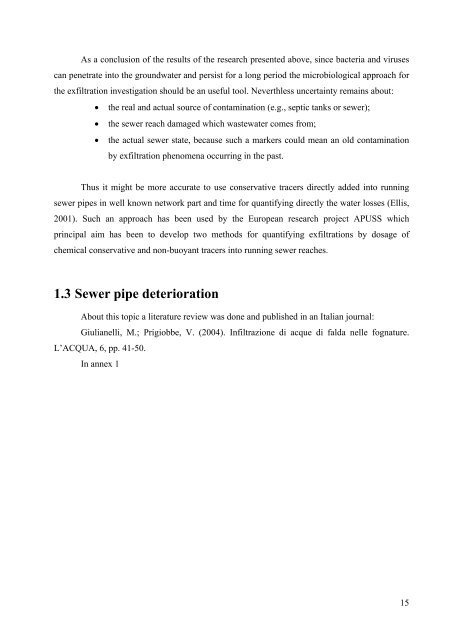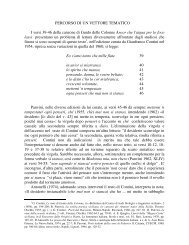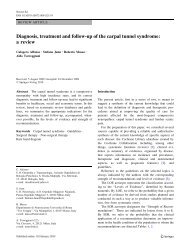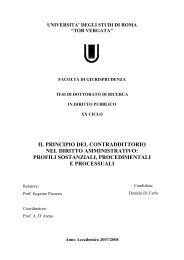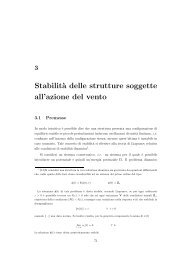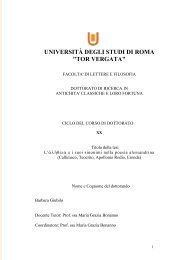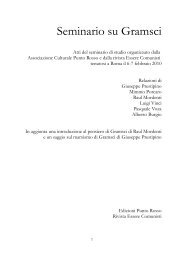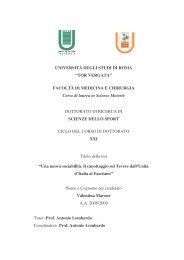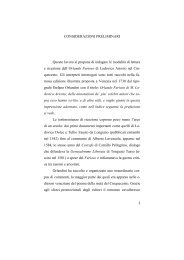- Page 1 and 2: Università degli studi di Roma “
- Page 3 and 4: INDEX CHAPTER 1 THE PROBLEM........
- Page 5 and 6: ANNEX 6 - PRIGIOBBE, V.; GIULIANELL
- Page 7 and 8: FIGURE INDEX FIG. 1.3.1: PPIS FOR I
- Page 9 and 10: MOTIVATION This dissertation presen
- Page 11 and 12: INTRODUCTION The thesis is divided
- Page 13 and 14: 2000; Jorgesen and halling-Sorensen
- Page 15: Concerning virus transport and surv
- Page 19 and 20: Sewer material Sewer joint type and
- Page 21 and 22: 2. data by field visits: condition
- Page 23 and 24: to be large enough to provide signi
- Page 25 and 26: Fig. 1.3.2: PPIs for infiltration (
- Page 27 and 28: well as cost-effective. Although it
- Page 29 and 30: drain and sewer system outside buil
- Page 31 and 32: Tab. 1.4-1: how to use diagnostic t
- Page 33 and 34: Dietrich, D. R..; Webb, S.F.; Petry
- Page 35 and 36: Rauch, W.; Stegner, Th. (1994). The
- Page 37 and 38: for the calibration and/or validati
- Page 39 and 40: If the complete mixing occurs the e
- Page 41 and 42: 2.2.3 Hydrodynamic background of QU
- Page 43 and 44: The three dimensional equation (Eq.
- Page 45 and 46: et = νt Eq. 2.2-15 but for buoyant
- Page 47 and 48: where y is the vertical axis [m] an
- Page 49 and 50: Fig. 2.2.4: Concentration profile d
- Page 51 and 52: Mid-Field and Transverse Mixing The
- Page 53 and 54: where = < u > = u * and Lt = water
- Page 55 and 56: The mixing distances are determined
- Page 57 and 58: The methods used for measuring the
- Page 59 and 60: This equation gives a Gaussian spat
- Page 61 and 62: where Kx is undimensionalized by b
- Page 63 and 64: time-varying concentration input at
- Page 65 and 66: at the confluence, because if exfil
- Page 67 and 68:
e. at the natural site the discorda
- Page 69 and 70:
2.2.4 Application Advection-Dispers
- Page 71 and 72:
2.2.5 Sampling and Measurements In
- Page 73 and 74:
2.3 Methods for Quantifying the Inf
- Page 75 and 76:
an urban sewer network. The chemica
- Page 77 and 78:
the various isotopes of an element
- Page 79 and 80:
3. biological reaction due to organ
- Page 81 and 82:
Fig. 2.3.4 Fractionation factors α
- Page 83 and 84:
isotopic fractionation than faster
- Page 85 and 86:
The dashed lines in Fig. 2.3.5 show
- Page 87 and 88:
In Italy, Longinelli and Selmo (200
- Page 89 and 90:
egions and it has been applied for
- Page 91 and 92:
2.4 Reference Best, J. L., and Roy,
- Page 93 and 94:
Kracht, O.; Gresch, M.; de Bennedit
- Page 95 and 96:
CHAPTER 3 Experimental Design and F
- Page 97 and 98:
and B 2 ⎛ ⎜ = ⎜2 ⎜ ⎜ ⎝
- Page 99 and 100:
After a general uncertainty analysi
- Page 101 and 102:
3.3 QUEST In this paragraph, the QU
- Page 103 and 104:
t= endIpeak M 2 e'( C exf = 1− t=
- Page 105 and 106:
Tab. 3.3-1: sources of uncertainty
- Page 107 and 108:
discussed, and a mathematical appro
- Page 109 and 110:
Overlapping Peak routine) is the ro
- Page 111 and 112:
Fig. 3.3.7: Conductivity peaks in g
- Page 113 and 114:
# INTEGRATION of Reference and Indi
- Page 115 and 116:
# regression time definition # ====
- Page 117 and 118:
samp[,2:length(par.vector.mean)]
- Page 119 and 120:
e
- Page 121 and 122:
n.ref
- Page 123 and 124:
{ Q.Ref[i]
- Page 125 and 126:
} # Plot # ==== range
- Page 127 and 128:
3.4 QUEST-C For the application of
- Page 129 and 130:
3.6 POLLUTOGRAPH METHOD The equatio
- Page 131 and 132:
Fig. 3.6.3: COD measurements after
- Page 133 and 134:
Tab. 3.6-1 and the hydrograph separ
- Page 135:
Annex 1 Giulianelli, M.; Prigiobbe,
- Page 147 and 148:
10 th International Conference on U
- Page 149:
Annex 3 Giulianelli, M.; Mazza, M.;
- Page 175:
Annex 5 Rieckermann, J.; Bareš, V.
- Page 187 and 188:
Application of a novel method for a
- Page 189 and 190:
Fig. 1 right: fractionation of 18 O
- Page 191 and 192:
The experimental area called Infern
- Page 193 and 194:
Table 1 data of isotopic compositio
- Page 195 and 196:
During the storage of wastewater sa
- Page 197 and 198:
Fig. 7 error propagation with Monte
- Page 199 and 200:
Majoube, M., 1971. Fractionnement e
- Page 201 and 202:
th 16P P European Junior Scientist
- Page 203 and 204:
By the administrative level, the ma
- Page 205 and 206:
Fig. 2 - “Node” topology elemen
- Page 207 and 208:
By topologic overlay (overlapping t
- Page 209:
References: [1] United Nations Divi
- Page 213 and 214:
VALENTINA PRIGIOBBE (A) , CLAUDIO S
- Page 215 and 216:
associare contemporaneamente alle m
- Page 217 and 218:
Fig. 2 - Sonda utilizzata per le mi
- Page 219 and 220:
Conductivity [microS/cm] 3700 3400
- Page 221 and 222:
Allo stato attuale di avanzamento d
- Page 223 and 224:
I metodi presentati in questo artic
- Page 225 and 226:
precipitazioni è variabile tra -9
- Page 227 and 228:
Area di indagine L’area speriment
- Page 229 and 230:
δ 18 O [per mille] 2.00 1.00 0.00
- Page 231 and 232:
Tabella 1 a cui si deve aggiungere
- Page 233:
10 th International Conference on U


